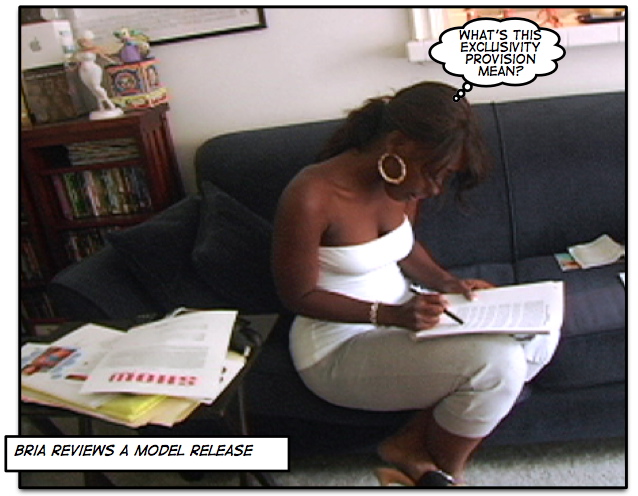Indochine's Top Shelf
The Model Release | Model Advice | Indochine's Top Shelf
The Model Release
04/26/08 02:41 Model AdviceModel Advice
As some of you already know, I’m a lawyer. In
addition to managing Bria Myles for a while, I have
extensive experience with contracts and litigation
and ran a calendar publishing business when I
graduated from UCLA Law School. That
calendar featured models and actresses like
Melissa De Sousa, Traci Bingham, Jossie Harris, Mari Morrow, and Amy Hunter, among others. It
was featured on Entertainment Tonight,
The Jenny Jones Show, Tavis
Smiley’s show, and was written about in the
Los Angeles Times. In
short, I’ve been around the modeling business for
a while and encountered most of the situations
today’s models have dealt with.
I welcome emails from aspiring models about the business on any and every topic. Each week, I’ll take on one of those questions and publish it here, in the “Model Advice” section.
The first of these entries is devoted to a subject that is often misunderstood: the dreaded model release and what your rights are after a photo shoot with or without one.
THE MODEL RELEASE – From the Model’s Perspective
What It Is; What Happens in the Absence of One
A model release is a document signed by the model that allows the photographer to use your pictures for commercial purposes. One of the biggest misconceptions about a model release is that it primarily benefits the model, but as the name implies, it is the model who is releasing rights. And generally the right being released is to have one's image or likeness commercially exploited. By the way, a commercial exploitation is anything concerning the use of your image in advertisements, promotional materials or product packaging, as well as the sale of products. Essentially, anytime your image is used to make money, it is a commercial use.
It's also important to understand that a photographer does not need a model release to display your photo to the public for noncommercial purposes, because he owns the copyright to any picture he takes of you. (Subject to the model's right of privacy. In California, the aforesaid is pretty much true, but in New York, where a written release is necessary to display anyone's photo for just about any reason, the photographer would still need the release.)
Photographer Owns the Copyright
Consider a common scenario: You ask a photographer friend to take some pictures of you. He photographs you in a swimsuit at the beach, but no release is signed and although he gives you a few image files, he keeps the CD. A few years later you hit it big and start to wonder what happened to those pictures you took way back when. Could they have made their way onto the internet? Been sold on eBay? Displayed in a newspaper or magazine?
Here's the deal: As the author of those images, your photographer friend is the holder of the copyright to them, which means he has the right to distribute them to the public, create derivative works from them, publish them for any newsworthy purpose, etc. It also means he can post them on the internet or anywhere else we wants, so long as it is not associated with a commercial use. (Which means he cannot sell your images on eBay, by the way, because that is a commercial use.)
If you want to prevent this, you have to enter into a contract with the photographer that provides that neither of you will display the images to the public without the other's consent.

What to Look For in Urban Magazine Model Releases
For magazines like BlackMen, KING, and Smooth a model release will almost always be required. You probably won't have the opportunity to contest any of the provisions of the release at the photo sessions without causing a fuss. The releases are often presented at the conclusion of the photo shoot and the model will feel pressured to just sign it and move on. It's pretty tough to tell an editor that just showered you with compliments and a great photo session that you won't sign the release because you don't like how it's worded.
For that reason, if possible, try to get a copy of the release you'll be asked to sign well in advance of the day you shoot. This way you can review it and raise any issues before your photo shoot.
The main "gotchas" that come up in these releases are exclusivity provisions and releases for video footage in addition to the still photos. An exclusivity provision will state that after you shoot with the magazine you are prohibited from shooting with any similar magazines for a certain period of time, sometimes up to a year. Generally, these are bad news. Urban models have a very short shelf life and even a 90-day exclusivity period can significantly chill a model's career. A year could kill it. Further, exclusivity provisions usually require additional consideration (money) to be enforceable under the law, and most magazine editors will not pay you extra to forego other opportunities.
As for the video footage releases, this language that is often packed into the release and overlooked by models. Let's say Smooth Magazine shoots you and while the still photography is taking place, you are also being video taped. Technically, you should get paid extra for the video footage if it is going to used for a commercial purpose, such as to sell a behind-the-scenes type DVD. But some of the editors will try to slip this in with the photo session release, so the amount you are paid for the use of your still images in the magazine also extinguishes your right to ask for any further money once a video comes out. Again, not at all favorable to the model.
Okay, that's a basic overview. Post any questions you have in comments, and I'll try to answer them.


I welcome emails from aspiring models about the business on any and every topic. Each week, I’ll take on one of those questions and publish it here, in the “Model Advice” section.
The first of these entries is devoted to a subject that is often misunderstood: the dreaded model release and what your rights are after a photo shoot with or without one.
THE MODEL RELEASE – From the Model’s Perspective
What It Is; What Happens in the Absence of One
A model release is a document signed by the model that allows the photographer to use your pictures for commercial purposes. One of the biggest misconceptions about a model release is that it primarily benefits the model, but as the name implies, it is the model who is releasing rights. And generally the right being released is to have one's image or likeness commercially exploited. By the way, a commercial exploitation is anything concerning the use of your image in advertisements, promotional materials or product packaging, as well as the sale of products. Essentially, anytime your image is used to make money, it is a commercial use.
It's also important to understand that a photographer does not need a model release to display your photo to the public for noncommercial purposes, because he owns the copyright to any picture he takes of you. (Subject to the model's right of privacy. In California, the aforesaid is pretty much true, but in New York, where a written release is necessary to display anyone's photo for just about any reason, the photographer would still need the release.)
Photographer Owns the Copyright
Consider a common scenario: You ask a photographer friend to take some pictures of you. He photographs you in a swimsuit at the beach, but no release is signed and although he gives you a few image files, he keeps the CD. A few years later you hit it big and start to wonder what happened to those pictures you took way back when. Could they have made their way onto the internet? Been sold on eBay? Displayed in a newspaper or magazine?
Here's the deal: As the author of those images, your photographer friend is the holder of the copyright to them, which means he has the right to distribute them to the public, create derivative works from them, publish them for any newsworthy purpose, etc. It also means he can post them on the internet or anywhere else we wants, so long as it is not associated with a commercial use. (Which means he cannot sell your images on eBay, by the way, because that is a commercial use.)
If you want to prevent this, you have to enter into a contract with the photographer that provides that neither of you will display the images to the public without the other's consent.

What to Look For in Urban Magazine Model Releases
For magazines like BlackMen, KING, and Smooth a model release will almost always be required. You probably won't have the opportunity to contest any of the provisions of the release at the photo sessions without causing a fuss. The releases are often presented at the conclusion of the photo shoot and the model will feel pressured to just sign it and move on. It's pretty tough to tell an editor that just showered you with compliments and a great photo session that you won't sign the release because you don't like how it's worded.
For that reason, if possible, try to get a copy of the release you'll be asked to sign well in advance of the day you shoot. This way you can review it and raise any issues before your photo shoot.
The main "gotchas" that come up in these releases are exclusivity provisions and releases for video footage in addition to the still photos. An exclusivity provision will state that after you shoot with the magazine you are prohibited from shooting with any similar magazines for a certain period of time, sometimes up to a year. Generally, these are bad news. Urban models have a very short shelf life and even a 90-day exclusivity period can significantly chill a model's career. A year could kill it. Further, exclusivity provisions usually require additional consideration (money) to be enforceable under the law, and most magazine editors will not pay you extra to forego other opportunities.
As for the video footage releases, this language that is often packed into the release and overlooked by models. Let's say Smooth Magazine shoots you and while the still photography is taking place, you are also being video taped. Technically, you should get paid extra for the video footage if it is going to used for a commercial purpose, such as to sell a behind-the-scenes type DVD. But some of the editors will try to slip this in with the photo session release, so the amount you are paid for the use of your still images in the magazine also extinguishes your right to ask for any further money once a video comes out. Again, not at all favorable to the model.
Okay, that's a basic overview. Post any questions you have in comments, and I'll try to answer them.



